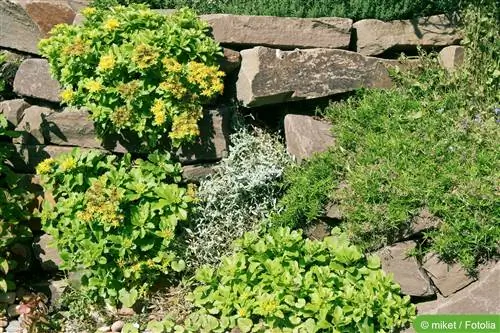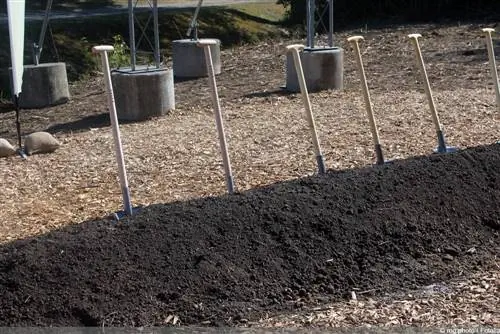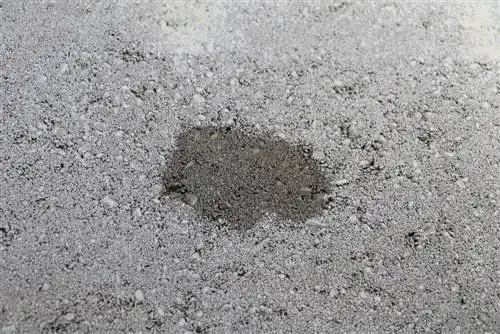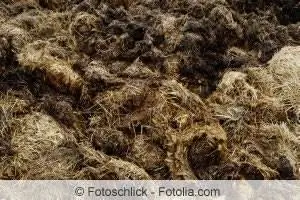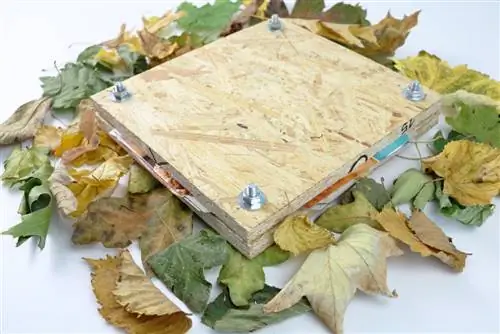- Author admin [email protected].
- Public 2023-12-17 03:39.
- Last modified 2025-01-24 12:45.
Dry stone walls not only serve to fortify slopes, but also create attractive accents in the terrain and at the same time contribute to biodiversity. With careful planning and preparation, it is easily possible for hobby gardeners to build a stable and visually appealing dry stone wall.
Suitable building material
Dry stone walls usually consist of quarry stones or roughly hewn stone blocks that are layered on top of each other without mortar. To ensure long durability, the stones used should not be damaged or have cracks. You should also make sure that the material is not too susceptible to weathering or has cavities. Apart from that, there are no limits to personal taste. Types of stone that are particularly popular for dry stone walls are:
- Granite
- Bas alt
- Limestone
- Sandstone
- Greywacke
When making your selection, however, it is advisable to use material from regional quarries. On the one hand, the dry stone walls built from them fit particularly harmoniously into the traditional landscape and, on the other hand, the costs are usually considerably lower.
Construction preparations
In order to build a stable dry stone wall, an equally stable foundation is necessary. This should have a width that is approximately a third of the planned height. In the case of a 1.50 m high wall, this would be at least 50 cm wide, which is why you should consider terracing on larger slopes. This is also supported by the fact that for walls that exceed a height of 2 m, a proof of stability must be drawn up by a certified structural engineer. Only a few materials and tools are necessary to build the foundation:
- Gravel or gravel
- Sand
- Split
- Pegs and string
- Inch rule
- Spade
- Rubber hammer or vibratory plate
First, the planned route of the wall is marked out using stakes and string. To make the construction of the wall easier, some distance should be allowed for from the existing slope, which will be filled with earth after the dry stone wall is completed. Then you dig out the ground to the desired width, about 40 to 50 cm deep. The resulting trench is filled about two-thirds with gravel or gravel and compacted thoroughly. Finally, the rest is filled with sand, which also needs to be carefully compacted. Chippings can be used as a top layer to give the drywall additional stability.
Laying up the drywall
Before construction of the actual wall begins, you should pre-sort the existing stones. The largest and heaviest stones are suitable for the first row of stones because they can support the slope particularly well. You should also choose slightly larger stones for the corners, which give the masonry additional stability. The smoothest and most beautiful stones can be saved for the top of the wall to create an attractive finish. After the first row has been laid as the foundation of the wall, the following rows are stacked staggered so that there are no cross joints that could affect the durability of the wall. Care must be taken to ensure that the stones rest firmly on each other and do not wobble. You may be able to tap them into place with a rubber mallet.
It is also important that the stones are stacked so that they are wider than they are high. At regular intervals, a stone should also be laid across the direction of the wall and the free space behind the wall should be filled up to this height. These stones serve as additional anchoring in the slope. If the area is very damp, it is recommended to lay a drainage pipe behind the wall. This means that the water can later drain away in a targeted manner and does not endanger the stability of the drywall. The resulting joints are filled with sand or grit or filled with topsoil and planted directly during the construction of the wall. The top of the wall can also be provided with a layer of soil and planted directly. Alternatively, you can choose particularly flat stones as a finish.
The most beautiful plants for dry stone walls
A large part of the appeal of dry stone walls is the lush vegetation, which not only provides unusual splashes of color in the garden, but also provides a habitat for many different animal species. If you don't want to wait for nature to do this work, you can plant plants on the wall during construction. This means that even larger plants can be inserted into the walls without damaging their roots. Of course, it is also possible to add greenery to an existing dry stone wall. However, this must be done with great caution and, in addition to normal soil, a planting substrate must also be used to ensure that the plants thrive.
Which plants can be used to green a dry stone wall depends on the region and location. In general, a distinction can be made between sunny, semi-shady and shady locations. The following plants particularly like it sunny:
- Pentecost carnation
- Carpet Silver Diamond
- Wallstone Herb
- Creeping Golden Sheaf
- Hanging cushion bell
The following are particularly suitable for semi-shady to shady locations:
- White Alpine Aster
- Blue Alpine Aster
- Golddroplets
- Dwarf woman's coat
- Spring sedge
The top of the wall itself can also be planted. Lush flowers that overhang the edge of the wall are particularly appealing. Of course, the location must also be taken into account here. The following plants can be used in warm, sunny locations:
- Blue pillow
- Summer Stonewort
- Wallstone Herb
- Stone purse
- Serbian sheaf
- Creeping Golden Sheaf
If the wall crown is in shade to partial shade, the following plants can thrive on it:
- Alpine Silver Coat
- Pink cat paws
- Caucasian goose cress
- Anthyllus
- Blue-stemmed striped fern
Care for the dry stone wall
If the dry stone wall has been carefully built and planted, no further care is usually necessary. If necessary, you should check the stability after extreme weather conditions with heavy rain. A stable wall usually holds and maintains itself, so that the hobby gardener can enjoy it for many decades.
As early as the Middle Ages, steep vineyards in the wine-growing regions of southwest Germany were terraced with the help of dry stone walls and protected from slipping. Today, however, many of these valuable habitats for plants, insects and lizards have disappeared. A good reason to use them as a useful and decorative design element in the garden.
What you should know about dry stone walls in brief
- For a dry stone wall, the stones are stacked loosely and dry (without mortar).
- Natural stones such as limestone or sandstone, travertine, shell limestone, gneiss and limestone are suitable.
- In order to be stable, the wall must be inclined inwards by about 15 percent from the base to the crown.
- Modeled stones can be built vertically on top of each other.
- Up to a height of 40 cm, the wall does not need a foundation.
When planting, you must pay attention to the direction of the wall sides. Heat-loving plants are right on the south side, while those that tolerate shade thrive on the north side.
Construction instructions
- The finished modeled tuff blocks are approximately 37 x 27 x 11 cm in size. This porous stone can be easily cut to the required dimensions using a diamond saw.
- The stones must be constructed so that the vertical joints do not lie on top of each other. For smaller spaces, cut the appropriate stones to size.
- The planting area becomes larger if the stones in the upper layer are chipped off at the edges with a chisel. The interior of the wall is filled with gravel, small stones and earth.
- You can easily cut out the side surfaces while the wall is being built. First fill some soil into this, then insert the thoroughly watered plants and fill the gaps with soil.
- There is plenty of space for plants on the top of the wall. If the wall is built wider, you can also plant dwarf shrubs in the (larger) planting area. Important: water well. The modeled volcanic tuff comes from Italy. This stone is available from natural stone companies or from landscape gardeners.
- The gneiss is worked with a setter (chisel) and a fist; for a wall made of quarry stones, the stones must be selected appropriately and fitted if necessary. If possible, the vertical wall joints should not lie on top of each other.
- The top of the wall is planted with perennials, grasses and small trees. Stones of different sizes are put together like a puzzle.
- Earth is filled between the walls of the wall. Add plenty of gravel and stones to ensure the soil is well permeable. To ensure that the individual bricks sit firmly, they are wedged together with suitable fragments.
- The joints are filled with soil and planted while the wall is being built. The plants must be watered before and after planting and during long periods of drought.

